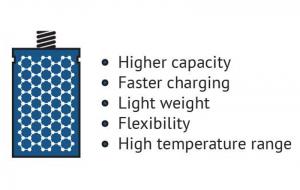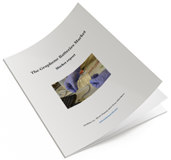Graphene batteries: Introduction and Market News - Page 20
Directa Plus signs MoU with NexTech Batteries to supply graphene for lithium sulphur battery production
 Italy-based Directa Plus recently signed a non-binding memorandum of understanding with NexTech Batteries, a company active in the field of lithium sulphur batteries based in Nevada, US.
Italy-based Directa Plus recently signed a non-binding memorandum of understanding with NexTech Batteries, a company active in the field of lithium sulphur batteries based in Nevada, US.
Under the terms of the agreement, Directa would supply its G+ graphene nanoplatelets to Nextech Batteries.
ZEN Graphene Solutions announces collaboration agreement on carbon aerogels with German Aerospace Center
 Zen Graphene Solutions recently announced that it has signed a new research collaboration agreement with the Deutsches Zentrum für Luft- und Raumfahrt (DLR, the German Aerospace Center) to investigate the use of Albany Pure graphene-based nanomaterials in the fabrication of novel carbon aerogel composites.
Zen Graphene Solutions recently announced that it has signed a new research collaboration agreement with the Deutsches Zentrum für Luft- und Raumfahrt (DLR, the German Aerospace Center) to investigate the use of Albany Pure graphene-based nanomaterials in the fabrication of novel carbon aerogel composites.
The goal of this collaborative research project titled, Development of Innovative Composites based on Carbon Aerogels, is to develop electrode materials for new generation batteries and will build on the collaboration between ZEN, DLR and Dr. Lukas Bichler at the University of British ColumbiaâOkanagan Campus (UBC-O) that was previously reported.
Talga Resources fast-tracks graphene-enhanced silicon anode product
 Talga Resources has provided an update on the commercial progress of its graphene-enhanced silicon anode lithium-ion battery product Talnode-Si. Following encouraging early test results, further technical and commercial development of Talnode-Si has been underway at Talga’s facilities in Europe.
Talga Resources has provided an update on the commercial progress of its graphene-enhanced silicon anode lithium-ion battery product Talnode-Si. Following encouraging early test results, further technical and commercial development of Talnode-Si has been underway at Talga’s facilities in Europe.
Results from this latest phase of development reportedly show continued success of Talga’s silicon anode approach which uses lower-cost metallurgical-grade silicon for a high-energy density anode with mass-producibility potential.
Graphene-Info updates all its graphene market report
Today we published new versions of all our graphene market reports. Graphene-Info provides comprehensive niche graphene market reports, and our reports cover everything you need to know about these niche markets. The reports are now updated to October 2020.
The Graphene Batteries Market Report:
- The advantages using graphene batteries
- The different ways graphene can be used in batteries
- Various types of graphene materials
- What's on the market today
- Detailed specifications of some graphene-enhanced anode material
- Personal contact details into most graphene developers
The report package provides a good introduction to the graphene battery - present and future. It includes a list of all graphene companies involved with batteries and gives detailed specifications of some graphene-enhanced anode materials and contact details into most graphene developers. Read more here!
What's new in graphene batteries? Highlights from summer 2020
The potential for improved performance and life cycle, fast charging and enhanced safety have proven to be enough of an incentive to inspire active study into graphene-based batteries, with many researchers and companies working globally to develop this energy Holy Grail.

Graphene-enhanced batteries seem to be one of those technologies that holds great promise and appeal, but always remains somewhat unattainable. Some batteries have been commercialized in which graphene was used to perform secondary functions - such as to enhance the casing flexibility or the heat dissipation abilities. These batteries have been launched in some markets - but this is not the breakthrough everybody is waiting for. Some claims have been made regarding actual graphene batteries. Some of these have been found to be outright scams while others have yet to form an actual presence on the market. It is also important to know that not all graphene-enhanced batteries actually use graphene - some use graphene derivatives or multi-layer graphene which is actual graphite.
In spite of all the above, advances are being made and milestones achieved, with some initial products entering the market and great amounts of funds invested into R&D. It is still our view that graphene holds great promise for the batteries of the future.
GAC establishes graphene unit to develop fast-charging EV Tech
Chinese EV maker Guangzhou Automobile New Energy (GAC), which announced last May that it has developed a graphene-enhanced battery for EVs which will be available for mass production at the end of this year, recently set up a unit that specializes in graphene and has begun research and development of fast-charging technology for electric vehicles.
Guangzhou Juwan Technology Research has registered capital of CNY58.8 million (USD8.6 million), according to statements by the Guangzhou-based company. It specializes in new materials and technologies, graphene and carbon products manufacture, battery production, emerging energy tech R&D, software development and sales of graphene materials.
Skeleton Technologies working on graphene “SuperBattery” for EVs, signs €1 billion LOI with a leading automotive manufacturer
 Estonian startup Skeleton Technologies is reportedly developing a graphene-enhanced SuperBattery that can be charged in just 15 seconds, and can go through hundreds of thousands of charge-recharge cycles without degrading. It was also reported that Skeleton recently signed a â¬1 billion letter of intent with a leading automotive manufacturer to bring the technology to market, most likely in 2023 according to Taavi Madiberk, founder and chief executive of Skeleton.
Estonian startup Skeleton Technologies is reportedly developing a graphene-enhanced SuperBattery that can be charged in just 15 seconds, and can go through hundreds of thousands of charge-recharge cycles without degrading. It was also reported that Skeleton recently signed a â¬1 billion letter of intent with a leading automotive manufacturer to bring the technology to market, most likely in 2023 according to Taavi Madiberk, founder and chief executive of Skeleton.
This will be a key enabler of the energy transition, says Madiberk. In most cases we see that batteries are not able to fully replace the older technologies â we still have hybrid vehicles or the need for backup generators.
KoreaGraph to test graphene li-ion batteries for fast charging electronics
![]() KoreaGraph, A Seoul-based graphene producer and applications developer, has announced that it is developing and testing graphene infused lithium-ion batteries for fast charging electronic applications.
KoreaGraph, A Seoul-based graphene producer and applications developer, has announced that it is developing and testing graphene infused lithium-ion batteries for fast charging electronic applications.
KoreaGraph has reportedly tested a variety of metals to provide suitable conductivity for fast charging applications but after numerous testing, graphene was found to be the safest material with an exceptionally high electric and thermal conductivity.
Xiaomi's Mi 10 Ultra smartphone said to sport "the first mass-produced graphene Li-ion battery"
Xiaomi's upcoming smartphone, the high-end Mi 10 Ultra, will reportedly be sporting "the first mass-produced 120W graphene battery".

Xiaomi claims the 4,500mAh graphene-based lithium-ion battery packs 1,000 times greater conductivity than traditional carbon black batteries. The brand was also quoted as saying that the battery remained at over 90% capacity after 800 charge and discharge cycles.
Conovate (formerly SafeLi) chosen for DoE advanced batteries project funding
The U.S. Department of Energy (DoE) recently announced the selection of 13 projects through a Battery Manufacturing Lab Call with combined funding of almost $15 million over three years. The call sought proposals from National Laboratories to establish public-private partnerships that address engineering challenges for advanced battery materials and devices, with a focus on de-risking, scaling, and accelerating adoption of new technologies.
One of the selected projects (Under the lead of Argonne National Laboratory) involves Wisconsin-based startup SafeLi (now renamed: Conovate), which will aim to scale-up the production of graphene monoxide for next-generation LIB anodes. In October 2019, SafeLi received a Small Business Technology Transfer (STTR) grant to develop lithium-ion battery parts made from a unique, patented material called graphene monoxide. This material is said to dramatically boost the energy storage capacity of li-ion batteries.
Pagination
- Previous page
- Page 20
- Next page
